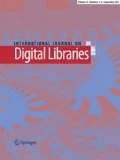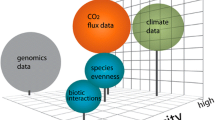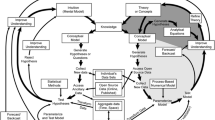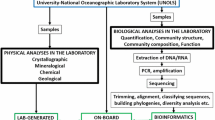Abstract
e-Science promises to increase the pace of science via fast, distributed access to computational resources, analytical tools, and digital libraries. “Big science” fields such as physics and astronomy that collaborate around expensive instrumentation have constructed shared digital libraries to manage their data and documents, while “little science” research areas that gather data through hand-crafted fieldwork continue to manage their data locally. As habitat ecology researchers begin to deploy embedded sensor networks, they are confronting an array of challenges in capturing, organizing, and managing large amounts of data. The scientists and their partners in computer science and engineering make use of common datasets but interpret the data differently. Studies of this field in transition offer insights into the role of digital libraries in e-Science, how data practices evolve as science becomes more instrumented, and how scientists, computer scientists, and engineers collaborate around data. Among the lessons learned are that data on the same variables are gathered by multiple means, that data exist in many states and in many places, and that publication practices often drive data collection practices. Data sharing is embraced in principle but little sharing actually occurs, due to interrelated factors such as lack of demand, lack of standards, and concerns about publication, ownership, data quality, and ethics. We explore the implications of these findings for data policy and digital library architecture. Research reported here is affiliated with the Center for Embedded Networked Sensing.
Similar content being viewed by others
References
Akyildiz I.F., Su W., Sankarasubramaniam Y. and Cayirci E. (2002). Wireless sensor networks: A survey. Comput. Networks 38: 393–422
Allaby, M. (ed.) (2006). A Dictionary of Ecology, 3rd ed. Oxford University Press, Oxford
ArXiv.org e-Print archive (2006). http://arxiv.org/. Visited 27 April 2006
Arzberger P., Schroeder P., Beaulieu A., Bowker G., Casey K., Laaksonen L., Moorman D., Uhlir P. and Wouters P. (2004). An international framework to promote access to data. Science 303(5665): 1777–1778
Bekaert, J., Van de Sompel, H.: Access interfaces for open archival information systems based on the OAI-PMH and the OpenURL framework for context-sensitive services. In: PV 2005: Ensuring Long-term Preservation and Adding Value to Scientific and Technical data. The Royal Society, Edinburgh (2006). http://www.ukoln.ac.uk/events/pv-2005/pv-2005-final-papers/032.pdf. Visited 28 Sept 2006
Bishop, A.P., Van House, N., Buttenfield, B.P. (eds.) (2003). Digital Library Use: Social Practice in Design and Evaluation. MIT Press, Cambridge, MA
Borgman, C.L.: The Interaction of community and individual practices in the design of a digital library. In: International Symposium on Digital Libraries and Knowledge Communities in Networked Information Society, University of Tsukuba, Tsukuba, Ibaraki, Japan (2004). http://www.kc.tsukuba.ac.jp/dlkc/e-proceedings/papers/dlkc04pp9.pdf. Visited 10 April 2006
Borgman C.L. (2006). What can studies of e-Learning teach us about e-Research? Some findings from digital library research. J. Comput. Supp. Cooperative Work 15(4): 359–383
Borgman C.L. (2007). Scholarship in the Digital Age: Information, Infrastructure and the Internet. MIT Press, Cambridge, MA
Borgman, C.L., Wallis, J.C., Enyedy, N.: Building digital libraries for scientific data: An exploratory study of data practices in habitat ecology. In: 10th European Conference on Digital Libraries, Alicante, Spain, Springer (2006)
Borgman, C.L., Bates, M.J., Cloonan, M.V., Efthimiadis, E.N., Gilliland-Swetland, A. J., Kafai, Y., Leazer, G. L., Maddox, A.: Social Aspects of Digital Libraries. Final Report to the National Science Foundation; Computer, Information Science, and Engineering Directorate; Division of Information, Robotics, and Intelligent Systems; Information Technology and Organizations Program (1996). http://is.gseis.ucla.edu/research/dl/index.html. Visited 28 Sept 2006
Botts, M.: Sensor Model Language (SensorML) for in-situ and remote sensors: Version 1.0.0 beta. Recommended paper, no. OGC 04-019r2.Open Geospatial Consortium (2004)
Botts, M.: Sensor Modelling Language (SensorML) Status (2006). http://stromboli.nsstc.uah.edu/SensorML/status.html. Visited 20 Nov 2006
Botts, M., McKee, L.: A Sensor Model Language: Moving sensor data onto the Internet. Sensors 20(Issue) (2003). Visited http://www.sensorsmag.com/articles/0403/30/main.shtml. Visited 20 Nov 2006
Bowker G.C. (2000). Mapping biodiversity. Int. J. Geograph. Inform. Sci. 14(8): 739–754
Bowker G.C. (2000). Biodiversity datadiversity. Social Studies of Science 30(5): 643–683
Bowker, G.C.: Work and information practices in the sciences of biodiversity. In: VLDB 2000, Proceedings of 26th International Conference on Very Large Data Bases, Cairo, Egypt, Kaufmann (2000)
Bowker G.C. (2005). Memory Practices in the Sciences. MIT Press, Cambridge, MA
Chudnov, D., Cameron, R., Frumkin, J., Singer, R., Yee, R.: Opening up openURLs with autodiscovery. Ariadne (43) (2005). http://www.ariadne.ac.uk/issue43/chudnov/. Retrieved 29 Sept 2006
Collaborative Large-Scale Engineering Analysis Network for Environmental Research (2006). http://cleaner.ncsa.uiuc.edu/home/. Visited 16 Aug 2006
Consortium of Universities for Advancement of Hydrologic Science. (2006) http://www.cuahsi.org. Visited 15 Nov 2006
Culler D.E. and Hong W. (2004). Wireless sensor networks. Commun. ACM 47(6): 30–33
Cummings, J. N., Kiesler, S.: Collaborative research across disciplinary and organizational boundaries. Soc. Stud. Sci. 35(5), 703–722 (2005). Retrieved from < Go to ISI>://000232598300003
David, P.A., Spence, M.: Towards institutional infrastructures for e-Science: the scope of the challenge. Oxford Internet Institute Research Reports, University of Oxford. http://129.3.20.41/eps/le/papers/0502/0502002.pdf. Visited 30 Sept 2006
Document Action: ‘The “info” URI Scheme for Information Assets with Identifiers in Public Namespaces’ to Informational RFC: Internet Engineering Task Force (2005). http://www1.ietf.org/mail-archive/web/ietf-announce/current/msg01746.html. Visited 8 Mar 2006
Ecological Metadata Language (2004). http://knb.ecoinformatics.org/software/eml/. Visited 25 Nov 2004
Elson J. and Estrin D. (2004). Sensor networks: a bridge to the physical world. In: Raghavendra, C.S., Sivalingam, K.M. and Znati, T.F. (eds) Wireless Sensor Networks. Kluwer Academic, Boston
Engeström Y. (1987). Learning by Expanding: An Activity-Theoretical Approach to Developmental Research. Orienta-Konsultit, Helsinki
Engeström, Y., Miettinen, R., Punamaeki , R.-L. (eds.) (1999). Perspectives on Activity Theory. Cambridge University Press, New York
Esanu, J.M., Uhlir, P.F. (eds.): Open Access and the Public Domain in Digital Data and Information for Science: Proceedings of an International Symposium. The National Academies Press, Washington, DC (2004) http://books.nap.edu/catalog/11030.html. Visited 30 Sept 2006
Estrin, D., Michener, W.K., Bonito,G.: Environmental cyberinfrastructure needs for distributed sensor networks: A report from a National Science Foundation sponsored workshop. Scripps Institute of Oceanography (2003). http://www.lternet.edu/sensor_report/. Visited 12 May 2006
Finholt, T.A.: Collaboratories as a new form of scientific organization. Econ. Innovat. New Technol. 12(January) (2003)
Ginsparg, P.: Creating a global knowledge network. Second Joint ICSU Press – UNESCO Expert Conference on Electronic Publishing in Science, Paris, UNESCO (2001). http://people.ccmr.cornell.edu/∼ginsparg/blurb/pg01unesco.html. Visited 12 May 2006
Glaser B.G. and Strauss A.L. (1967). The Discovery of Grounded Theory; Strategies for Qualitative Research. Aldine Pub. Co., Chicago
Global Earth Observation System of Systems (2006). http://www.epa.gov/geoss/. Visited 30 April 2006
Global Ocean Observing System (2006). http://www.ioc-goos.org/. Visited 5 June 2006
Godby, C.J., Young, J.A., Childress, E.: A repository of metadata crosswalks. D-Lib Mag. 10(12) (2004). http://www.dlib.org/dlib/december04/godby/12godby.html. Retrieved 22 May 2006
Gray, J., Liu, D.T., Nieto-Santisteban, M., Szalay, A., DeWitt, D., Heber, G.: Scientific data management in the coming decade. CT Watch Quart. 1(1) (2005). http://www.ctwatch.org/quarterly/articles/2005/02/scientific-data-management/. Retrieved 25 Aug 2006
Hey, T., Trefethen, A.: The data deluge: an e-Science perspective. Grid Computing—Making the Global Infrastructure a Reality. Wiley (2003). http://www.rcuk.ac.uk/escience/documents/report_datadeluge.pdf. Visited 20 Jan 2005
Hey T. and Trefethen A. (2005). Cyberinfrastructure and e-Science. Science 308: 818–821
Hilgartner S. and Brandt-Rauf S.I. (1994). Data access, ownership and control: toward empirical studies of access practices. Knowledge 15: 355–372
Hodge, G., Frangakis, E.: Digital preservation and permanent access to scientific information: the state of the practice. In: The International Council for Scientific and Technical Information (ICSTI) and CENDI: U.S. Federal Information Managers Group (2005). http://cendi.dtic.mil/publications/04-3dig_preserv.html. Visited 30 Sept 2006
Integrated Ocean Observing System (2006). http://www.ocean.us/what_is_ioos. Visited 5 June 2006
International Virtual Observatory Alliance (2006). http://www.ivoa.net/. Visited 30 Sept 2006
James San Jacinto Mountains Reserve: University of California (2004). http://www.jamesreserve.edu/. Visited 30 Nov 2004
Kwa C. (2005). Local ecologies and global science: discourses and strategies of the International Geosphere-Biosphere Programme. Soc. Stud. Sci. 35(6): 923–950
Latour B. (1987). Science in Action: How to Follow Scientists and Engineers through Society. Harvard University Press, Cambridge, MA
Latour B. and Woolgar S (1986). Laboratory Life: The Construction of Scientific Facts, 2nd edn. Princeton University Press, Princeton
Lofland J., Snow D., Anderson L. and Lofland L.H. (2006). Analyzing Social Settings: A Guide to Qualitative Observation and Analysis. Wadsworth/Thomson Learning, Belmont, CA
Long-Lived Digital Data Collections: Enabling Research and Education for the 21st Century: National Science Board (2005). http://www.nsf.gov/nsb/documents/2005/LLDDC_report.pdf. Visited 1 October 2006
Lord, P., Macdonald, A.: e-Science Curation Report-Data Curation for e-science in the UK: An Audit to Establish Requirements for Future Curation and Provision. JISC Committee for the Support of Research (2003). http://www.jisc.ac.uk/uploaded_documents/e-scienceReportFinal.pdf.Visited 1 October 2006
Maurer J. (2004). Models of Scientific Inquiry and Statistical Practice: Implications for the structure of scientific knowledge. In: Taper, M.L., Lele, S.R. and Znati, T.F. (eds) The Nature of Scientific Evidence: Statistical, philosophical, and empirical considerations., pp 17–50. The University of Chicago Press, Chicago, London
Michener, W.K., Brunt, J.W. (eds.) (2000). Ecological Data: Design, Management and Processing. Blackwell Science, Oxford
National Ecological Observatory Network (2006). http://neoninc.org/. Visited 3 October 2006
National Office for Integrated and Sustained Ocean Observations (2006). http://www.ocean.us/. Visited 5 June 2006
Object Reuse and Exchange (2006). http://www.openarchives.org/ore/. Visited 15 Nov 2006
Olson, G.M.: Long distance collaborations in science: Challenges and opportunities. In: First International Conference on e-Social Science, Manchester, UK, National Center for e-Social Science (2005) http://www.ncess.ac.uk/events/conference/ 2005/papers/presentations/ncess2005_olson.pdf. Visited 20 Nov 2006
Olson G.M. and Olson J.S. (2000). Distance matters. Human–Comput Interact. 15(2–3): 139–178
Pottie G.J. and Kaiser W.J. (2000). Wireless integrated network sensors. Commun. ACM 43(5): 51–58
Pottie G.J. and Kaiser W.J. (2006). Principles of Embedded Networked Systems Design. Cambridge University Press, Cambridge
Price D.J.d.S. (1963). Little Science, Big Science. Columbia University Press, New York
Pritchard, S.M., Carver, L., Anand, S.: Collaboration for knowledge management and campus informatics. University of California, Santa Barbara (2004). http://www.library.ucsb.edu/informatics/informatics/documents/UCSB_Campus_ Informatics_Project_Report.pdf. Visited 5 July 2006
Reference Model for an Open Archival Information System: Recommendation for Space Data System Standards, Consultative Committee for Space Data Systems Secretariat, Program Integration Division (Code M-3), National Aeronautics and Space Administration (2002). http://public.ccsds.org/publications/archive/650x0b1.pdf. Visited 4 October 2006
Sandoval W.A. and Reiser B.J. (2003). Explanation-driven inquiry: integrating conceptual and epistemic supports for science inquiry. Sci. Educat. 87: 1–29
Schnase, J.L., Lane, M.A., Bowker, G.C., Star, S.L., Silberschatz, A.: Building the next generation biological information infrastructure. In: Raven, P.H., Williams, T., (eds.). Nature and Human Society: The Quest for a Sustainable World. National Academy Press, Washington, DC, pp. 291–300. http://darwin.nap.edu/books/0309065550/html. Visited 4 October 2006
Sensor Modeling Language (2005). http://vast.uah.edu/SensorML/. Visited 16 Jan2006
Shankar, K.: Scientific data archiving: the state of the art in information, data, and metadata management (2003). http://cens.ucla.edu/Education/index.html. Visited 19 Jan 2005
Sharing Data from Large-scale Biological Research Projects: a System of Tripartite Responsibility: Meeting organized by the Wellcome Trust, Fort Lauderdale, Florida, Wellcome Trust (2003). http://www.wellcome.ac.uk/assets/wtd003207.pdf. Visited 25 July 2005
Sonnenwald, D.H.: Scientific collaboration: challenges and solutions. In: Cronin, B. (ed.) Annual Review of Information Science and Technology. Information Today, Medford, NJ, Vol. 41, pp. 643–682 (2007)
Southern California Coastal Ocean Observing System (2006). http://www.sccoos.org\ . Visited 5 June 2006
Thadani, V., Cook, M., Millwood, K., Harven, A., Fields, D., Griffis, K., Wise, J., Kim, K., Sandoval, W.A.: Eyes on the prize: considering how design research can lead to sustainable innovation. Paper presented at the Annual Meeting of the American Educational Research Assn., San Francisco, April 7–12 (2006)
Traweek S. (1992). Beamtimes and Lifetimes: The World of High Energy Physicists, 1st Harvard University Press pbk. edn. Harvard University Press, Cambridge
Traweek S. (2004). Generating high energy physics in Japan. In: Kaiser, D. (eds) Pedagogy and Practice in Physics., pp. University of Chicago Press, Chicago
U.S. Long Term Ecological Research Network (2006). http://lternet.edu/. Visited 5 June 2006
Van de Sompel, H., Nelson, M.L., Lagoze, C., Warner, S.: Resource harvesting within the OAI-PMH framework. D-Lib Mag. 10(12) (2004). http://www.dlib.org/dlib/december04/vandesompel/12vandesompel.html. Retrieved 5 October 2006
Van de Sompel, H., Hammond, T., Neylon, E., Weibel, S.L.: RFC 4452: The “info” URI Scheme for Information Assets with Identifiers in Public Namespaces. Requests for Comments, Internet Engineering Task Force (2006). http://www.rfc-archive.org/getrfc.php?rfc=4452. Visited 5 October 2006
Van House, N.A. (2003). Digital libraries and collaborative knowledge construction. In: Bishop, A.P. and Buttenfield, B.P. (eds) Digital Library Use: Social Practice in Design and Evaluation., pp 271–296. MIT Press, Cambridge
Wallis, J.C., Milojevic, S., Borgman, C.L., Sandoval, W.A.: The special case of scientific data sharing with education. American Society for Information Science& Technology. Information Today, Austin (2006)
Weinberg A.M. (1961). Impact of large-scale science on the United States. Science 134(3473): 161–164
Zimmerman, A.: (in press). Not by metadata alone: The use of diverse forms of knowledge to locate data for reuse. Int. J. Dig. Lib.
Zimmerman, A., Nardi, B.: Whither or whether HCI: Requirements analysis for multi-sited, multi-user cyberinfrastructures. CHI 2006, Montreal, Association for Computing Machinery, pp. 1601–1606 (2006)
Zimmerman, A.S.: Data Sharing and Secondary Use of Scientific Data: Experiences of Ecologists. School of Information, University of Michigan, Ann Arbor, MI (2003)
Zimmerman, A.S.: (in press). New knowledge from old data. The role of standards in the sharing and reuse of ecological data. Sci. Technol. Human Values
Author information
Authors and Affiliations
Corresponding author
Rights and permissions
About this article
Cite this article
Borgman, C.L., Wallis, J.C. & Enyedy, N. Little science confronts the data deluge: habitat ecology, embedded sensor networks, and digital libraries. Int J Digit Libr 7, 17–30 (2007). https://doi.org/10.1007/s00799-007-0022-9
Published:
Issue Date:
DOI: https://doi.org/10.1007/s00799-007-0022-9




